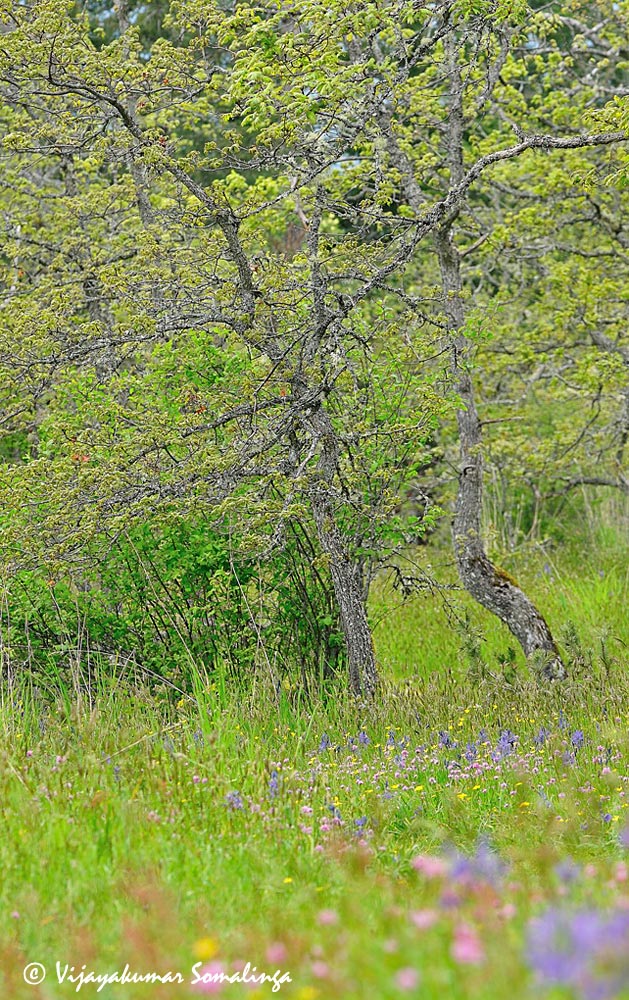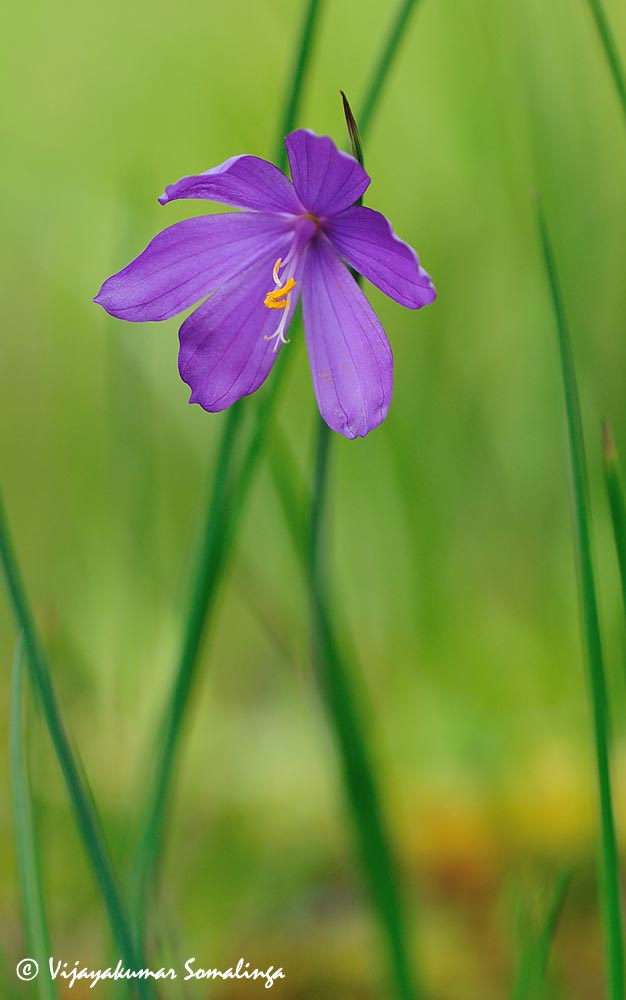Guest Post by Vijay Somalinga
Last summer I was having a conversation with a friend about the native flora of British Columbia. I was quite disappointed when I learned that most of the the flower pictures I had taken that summer turned out to be invasive and non-native species. It was during this conversation that for the first time I heard the term “Garry oak meadows.” A little research about the Garry Oak meadows had me itching to go see this unique ecosystem. However, I had to wait for a year since it was almost the end of the flowering season. Fast forward to April, 2011, and I finally got my first opportunity to see this unique ecosystem.
The Garry Oak Meadows
Garry oak meadows are a part of the Coastal Douglas Fir ecosystem that occurs as a narrow strip along the southeastern tip of Vancouver Island in the rain-shadow of the majestic Olympic Mountains of Washington State in the U.S and the Vancouver Island ranges. These mountains block the moisture-laden clouds making the Garry Oak ecosystems tinder-dry in summer and mild and wet (although not as wet as other regions of the Pacific Northwest) in winter. The Garry Oak meadows are sparsely forested and are dominated by the gnarly Garry Oak (Quercus garryana). Other trees that are found here include the beautiful and the threatened Arbutus (Arbutus menziesii) and the Douglas-fir (Pseudotsuga menziesii). The understory is composed mainly of grasses, shrubs and other herbaceous plants.

Fire and the Garry oak Ecosystem
Garry Oak meadows are not entirely natural. The Vancouver Island Coast Salish people used controlled burning to keep these meadows open to allow the growth of Camas (Camassia spp.). The bulbs of Camas were an important food source for the Coast Salish. The Garry Oak meadows maintained by the Coast Salish were of the deep soil type and are know as the Parkland Garry Oak ecosystem. Nearly 95% of these Parkland Garry Oak meadows has been lost to urban development and agriculture. The majority of the Garry Oak meadows found now are the Scrub oak ecosystem that occurs in rocky habitats with shallow soil. Natural fire from lightning strikes probably played a major role in keeping these meadows open and free of large trees encouraging the growth of numerous flowering plants.
Flowers of the Garry oak meadows
The Garry Oak meadows is one of the richest ecosystem in Canada. It supports hundreds of plant and bird species along with numerous reptiles, amphibians and mammals. Each spring and summer, the Garry Oak meadows puts up an impressive floral display. One of the first flowers to bloom are the delicate Douglas’ Grasswidows (Olsynium douglasii). Also know as Satinflowers, they grow in grass-like clumps with the flowers held at the tip of the stem.
Flowering at Garry Oak meadows peaks during the month of May. The Camas dominate the meadows during this time of the year, transforming them into a sea of blue. Camas are perennial plants and grow to a height of 12 to 15 inches. The flowers are generally deep blue but the colour can vary from deep purple to white. The sight of Camas in full bloom is a sight to behold.

The Garry Oak meadows also boast a number of highly endangered plants and animals. One such highly endangered plant is the Deltiod Balsamroot (Balsamorhiza deltoidae). Numbering only 1600 mature flowering plants, Deltoid Balsamroot is a red-listed species in British Columbia. Deltoid Balsamroot flowering peaks in May with showy large yellow flowers resembling sunflowers. A viable flowering population of Deltoid Balsamroot can be seen at the Mt. Tzouhalem Ecological Reserve in Duncan on Vancouver Island, British Columbia.

As flowering season progresses, numerous other plants come into bloom. In early spring the meadows are dominated by Shooting stars (Dodecatheon sp.), clumps of Satin flowers (Olysnium douglasii), Sea blush (Plectritis congesta), Fawn lilies (Erythronium oreganum) and Chocolate lilies (Fritillaria affinis). In late spring and early summer Camas dominate the meadows along with Western buttercups (Ranunculus occidentalis), Death Camas (Zigadenus venenosus) and Menzies’ Larkspur (Delphinium menziesii).

As the summer peaks, the meadows dry out and at the height of summer the meadows turn from a sea of blue and green to a golden brown as the sun beats down. The floral display is not as impressive as spring but the summer flowers make it up by their sheer vibrancy. Deep purple flowers of Harvest Brodiaea (Brodiaea coronaria), pink inflorescence of Hooker’s Onion (Allium acuminatum), umbel-shaped white flowers of Fool’s Onion (Triteleia hyacinthina), yellow arnica’s (Arnica spp.) among other flowers dot the dry landscape. By the end of July the flowering season is over and the meadows wait for the next flowering season.
Threats to Garry Oak Meadows
The Garry Oak meadows is an ecosystem in peril. Land development is one of the biggest threats to the Garry Oak meadows. Uncontrolled urban expansion and agricultural development has fragmented the Garry Oak ecosystem making them vulnerable to extirpation. Fire plays an important role in keeping the Garry Oak meadows open. Present day fire suppression encourages the growth of shrubs and Douglas fir that can eventually convert the meadows into a forested ecosystem. Invasive species such as Scotch Broom (Cytisus scoparius), English Ivy (Hedera helix), Himalayan Blackberry (Rubus armeniacus) and other introduced grasses pose a huge threat to this fragile ecosystem. If proper measures are not taken to revive and preserve this unique ecosystem it will be lost forever.
Useful Links and Further reading
- Garry Oak Ecosystems Recovery Team
- Native Plant Society of BC
- Native Plant Study Group
- Mill Hill Regional Park
About the Contributor
A microbiologist by profession, wildlife and nature has been a life long passion for Vijay Somalinga. He started taking photography seriously a few years ago and has authored a self-published photography book called “Backyard Bugs.” His images depict wild life in their natural environment and create awareness about endangered species and regions of the world. Visit his blog Mountains to Mudflats to see more of his photographs.